Paper Doll
Paper Doll Wraps Up the Holiday Season (Sneakily, Diagonally, and Intangibly)

Welcome to the home stretch of the holiday season.
Maybe you’re reading this while standing in a long line because this is the first chance you’ve had to shop and you were shocked to find that your favorite online store sold out of the only thing on your special person’s list.
Perhaps you bought all your presents last summer, wrapped and labeled them, and stored them in your secret hiding place months ago.
Either way, how are you going to keep the gifts a surprise until unwrapping time?
HIDING PLACES
I think the best place to keep gifts, wrapped or otherwise, from the prying eyes of tiny humans and others with insatiable curiosity is in an old suitcase. People will check under beds and in closets, but nobody looks in those cheerless valises in the basement, the ones that are faux leather and lack wheels and haven’t been used in 40+ years.
Yes, as a professional organizer, I encourage people to donate or recycle things that they don’t use, but quietly repurposing that blue suitcase circa 1978 counts as recycling!
Other options worth considering:
- Hidden in plain site — Would your kids (or your spouse) show any interest in prying up the lid of a Bankers Box labeled “2015 Tax Receipts,” “college textbooks,” or something similarly boring? Probably not. (Piling other stuff on top couldn’t hurt.) If you’re the only one in your house who cooks, a small wrapped gift or two hidden in the back of a kitchen cabinet, inside a rarely-used fondue pot, may be just what you need to stymie the sneaky searchers.
- Your friends’ & neighbors’ houses — One solution is just to trade storage. Take your wrapped gifts in boxes or lidded tubs to your cousin’s, co-worker’s, or BFF’s place, and return with hers. You can even tell your family not to bother snooping because you’ve made this trade. (Note: if your kids and their kids are friends, one may spy on the other’s behalf.)
- The trunk of your car — Obviously, this works in only two situations, when you normally have an incredibly tidy trunk (with ample room to store a gift-filled box labeled “work project”) or if you normally have a predictably packed and untidy trunk (in which case you need to hollow it out and hide gifts underneath the faux facade of mess. (Do not mark any boxes as “donations” or someone may unhelpfully deliver all your holiday gifts to charity!)
- Attics — The upside is that children and pets generally can’t get up to the attic on their own. The downside? It’s probably not that easy for you to get up there, either. Also, it’s probably dusty, there may be “critters” and there’s almost certainly temperature and humidity variations throughout the year. Keep that in mind if you’re storing any gifts that are sensitive to those kinds of changes, and store the gifts in a tightly lidded tub.
- Laundry hamper — Let’s face it; nobody is enthusiastic about doing laundry. Your kids aren’t about to suddenly volunteer to take the laundry from your room, even to please Santa.
- Trash bags — Big, black trash bags or leaf bags, especially if you have an attic, or garage, or basement with a variety of things already obscured by bags, may be the ticket. The problem? If there’s anyone who ever visits your house trying to be “helpful,” they may assume it’s trash and toss it out.
If your storage is at a premium and you have to keep wrapped gifts out and on display — and this trick works once you’re ready to put the gifts under the tree — fake the name tags. Instead of Mom, Dad, Aunt Jen, etc., make yourself a cheat sheet matching real names to “gift” names and put presents out for Lizzo, Daenerys, Baby Yoda, and so on.
WRAPPING SAVVY
Paper Doll is terrible at wrapping any gifts that don’t come in perfectly rectangular shapes. Back in NAPO2014: It’s a Wrap! Organizing Your Wrapping Supplies with Wrap It!, I told a story of my wrapping failures (and shared this adorable photo of a now-late-20s young man).
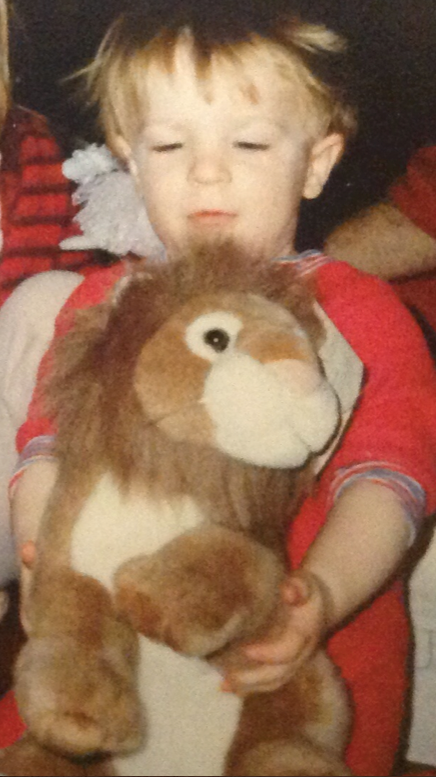
Many years ago, I offered up some alternatives for people with wrapping skill deficits:
It’s a Wrap! Wrapping Paper Alternatives, Furoshiki & Frogs (2008)
Paper Doll Wraps Up the Holidays and Makes It All Stick (Part 1) (2011)
Paper Doll Wraps Up Some Alternatives to Wrapping Paper (Part 2) (2011)
I’m obviously not the only person who has trouble wrapping presents, because the hottest video on the internet in the past few weeks has been one that went viral with ways to wrap gifts in unusual ways, and especially spotlighting wrapping gifts diagonally.
In case you haven’t seen it, be sure to press PLAY below and crank the volume. Oh, and stop by @BlossomHacks to give them some love. As often happens on the internet, credit got lost along the way, and most people were not aware that Blossom DIY created the video (which UK bookseller Waterstones made viral).
Wrapping gifts got a whole lot easier with these clever ideas! pic.twitter.com/sP4MXhpBBu
— Blossom (@BlossomHacks) December 14, 2019
By the way, if you care, Popular Mechanics has a feature on the math behind the diagonal wrapping hack.
WRAPPING and PACKING and SHIPPING, OH MY!
Finally, I’m an organizing and productivity expert, not a wrapping, packing, and shipping expert (my recent post, This “Magic” Product Makes Shipping Packages as Easy as Wrapping Leftovers, notwithstanding).
Luckily, our friends at Quill have more expertise on these issues and have been kind enough to share their infographic to take you through each of these holiday headaches with aplomb.
 Gift wrapping, packing, and shipping hacks to save money and make your life easierInfographic by Quill
Gift wrapping, packing, and shipping hacks to save money and make your life easierInfographic by Quill
A FINAL WORD
Of course, the best gifts don’t necessarily need to be wrapped or shipped. As we’ve talked about many times, gifts don’t need to be things at all.
We’ve spoken many times about how you can give gifts of experiences. Consider adventures (like the NASCAR Racing Experience or an afternoon in an escape room), entertainment (tickets to sporting events, museum exhibits, concerts, theater events, six months of Netflix or Hulu, or a year of Amazon Prime), practicality (gift certificates for car washes or an auto club membership like AAA), or consumables (homemade or subscription-based, or gift certificates to restaurants or coffee houses). And, of course, gifts of organization and productivity never go amiss.
Happy holidays, and I hope whatever you give (and receive) gifts makes life a little (or a lot) more joyous.
This “Magic” Product Makes Shipping Packages as Easy as Wrapping Leftovers
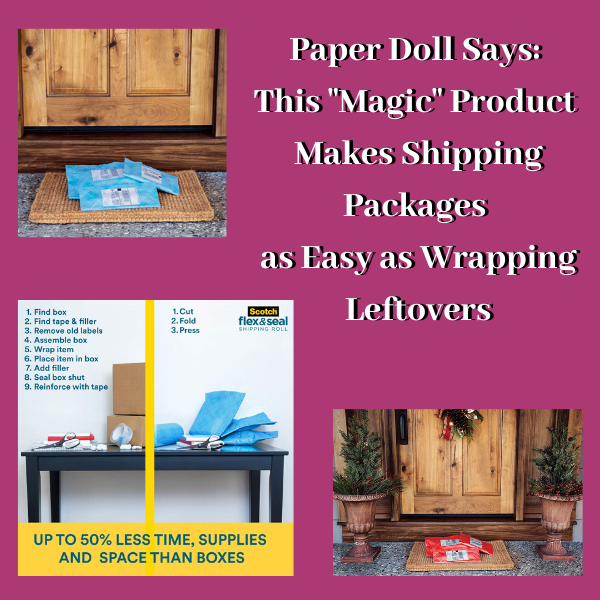 Packing and shipping is not exactly rocket science. And yet Paper Doll hears a lot about shipping-avoidance and packing-box frustration. In a perfect world, whenever we wanted to ship something, we’d have the ideal sized box (so as not to waste space, and also not to have one of those almost-sealed, bulging boxes where the flaps quite don’t meet). We’d also have just the right amount of padding material to prevent jostling, and it would all be easily recyclable.
Packing and shipping is not exactly rocket science. And yet Paper Doll hears a lot about shipping-avoidance and packing-box frustration. In a perfect world, whenever we wanted to ship something, we’d have the ideal sized box (so as not to waste space, and also not to have one of those almost-sealed, bulging boxes where the flaps quite don’t meet). We’d also have just the right amount of padding material to prevent jostling, and it would all be easily recyclable.
My clients tell me they procrastinate on returning purchases and shipping care packages, birthday gifts, and other things because – although they have lots of boxes and bubble mailers thanks to their online shopping habits – nothing is ever the right size. This isn’t just a frustration; it’s also a financial issue.
In 2015, the major players in the ground shipping world, like UPS and FedEx, stopped pricing solely by the pound. They realized that a lot of relatively light packages were being shipped, and that cost them money. So, they started using dimensional weight, which had already been the practice for air-shipped packages.
What is dimensional weight?
The shipper calculates the cubic size of a package by multiplying its length, width, and height. Once the dimensional weight is calculated, they compare it to the actual weight of the package and the larger of the two is used to determine the package’s actual “billable” weight.
Need some help with the math? Google dimensional weight shipping calculators, like this one from ShippingEasy.com.

What does this all mean for you? A small thing in a bigger box will cost you more than that same thing in a smaller box, which means you have to keep even more shipping supplies on hand to find the just-right solution, and that causes clutter.
If only someone had a better idea. Oh, wait. Someone did!
SCOTCH™ FLEX & SEAL SHIPPING ROLL
3M is a marvel of innovation. The same parent company that brought us Post-It® Notes and Command hooks has done it again. They’ve invented a shipping solution that requires keeping less packing material and fewer supplies, takes less time, and creates a smaller dimensional weight for the things you ship.
And, honestly, I’m not persuaded that it isn’t some kind of magic.
Scotch™ Flex & Seal Shipping Roll
First, let’s get an overview of the product, with some fun, bouncy music.
Cool, eh? So, let’s dig deeper. How does this product save space, time, and money?
Eliminate clutter
What do you keep on hand for shipping packages? Boxes, right? Probably lots and lots of Amazon (and other) boxes. Maybe USPS “priority” boxes (which always seem to be way too large or just a little too shallow)? A family member bought a gorgeous Kitchenaid stand mixer and had it shipped. It came in a glossy, specially-carved Kitchenaid box (with a photo of the mixer on the package) inside a matching, plain, cardboard Kitchenaid-branded box (each with specially-placed handles for ergonomic carriage) and the whole thing was inside a box that would have made a nice toddler playhouse.
I bet you don’t just hoard boxes. I bet you have bubble wrap. (And not nice rolls of bubble wrap, but pre-used bubble wrap that someone in your house has popped and flattened along the edges, right?) Or maybe you have styrofoam peanuts. Or those clear, little balloons that look like nothing so much as an inflated zip-lock sandwich bag without the zipper?
And where are you storing these cardboard boxes, bubble mailers, poly bags, bubble wrap, and package stuffing? Probably wherever you can find to put it, and likely not in a very sound system. (No, I’m not peeking in your windows while you’re sleeping. Promise!)
Because the Flex & Seal allows you to customize your package to fit precisely around the edges of your item, there’s no wasted space in the box and no unnecessary padding to keep on-hand. Scotch’s marketing claims to save up to 50% on supplies, time, and space vs. using boxes. I don’t know how they arrived at that statistic, but it does mean that you can take up less space, and the roll can be stored horizontally or vertically, like a rolled-up yoga mat.
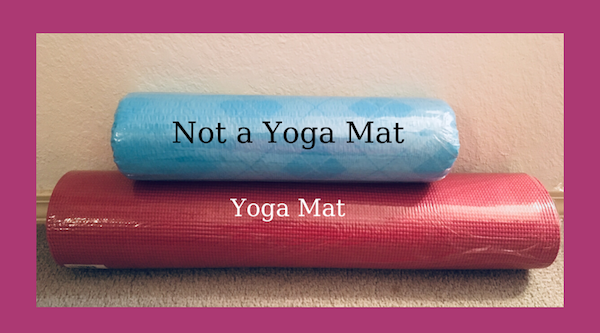
Save time
My clients are invariably piling up to-be-shipped items on the dining room table or on kitchen counters because they anticipate (often correctly) that it will be time-consuming to find a suitably-sized box, pad and pack the item(s) safely, and seal everything confidently. Scotch™ Flex & Seal Shipping Roll promises make packing as simple as:
- Cut a piece of the roll long enough to sandwich the item you’re shipping.
- Fold the Flex & Seal over whatever you’re shipping.
- Press to seal it by continuing to press around the three (non-folded) edges. (Imagine you’re wrapping your Thanksgiving leftovers in aluminum foil before putting them in the freezer. Or, as the product’s web site says, “Make sure you’re pressing gray surface to gray surface. A helpful way to remember it: Do not wrap like a present, fold and press like a calzone!”)
That’s it. Print out your label and affix it to the package. Wheeeee!
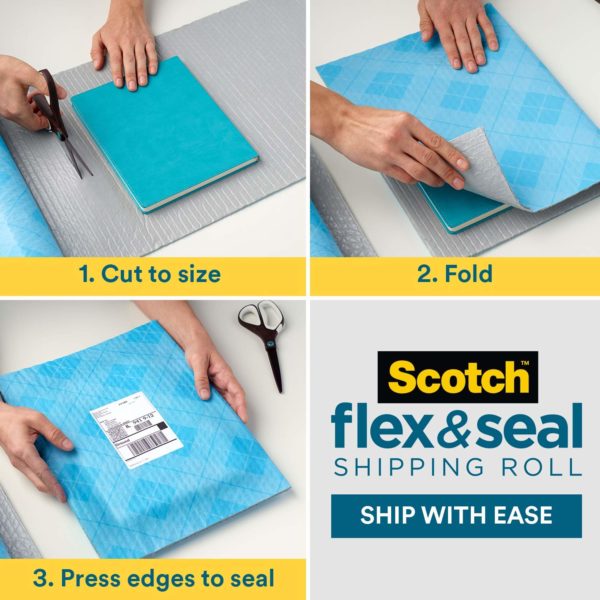
Secure and immobilize your package.
Scotch™ Flex & Seal Shipping Roll may look like a prettier version of bubble wrap, but it harbors a secret superpower. Flex & Seal is constructed with three layers.
The blue outer layer is tough and durable, making the package water-resistant and tear-resistant. The clear middle layer is bubble wrap, but seems slightly less inflated (and is difficult to pop), creating firm cushioning for the package.
And the grey inner layer is MAGIC. (OK, I’m sure it’s science, but Paper Doll can’t figure out how it works!) This inner layer’s “adhesive technology” makes it stick securely to itself but not whatever you’re shipping!
Scotch™ Flex & Seal Shipping Roll sticks to itself and not to what you put inside! What kooky shipping witchcraft is this? Share on XOnce you fold the Flex & Seal over your item (sandwiching it), just press firmly for a guaranteed seal. Folded and smushed (for another scientific term), the Flex & Seal conforms to the shape of whatever you’re shipping, immobilizing it to protect against wiggling during shipping.

Save money.
The marketing for the Flex & Seal Shipping Roll notes that by eliminating extra packing and shipping supplies, and securely sealing around the shape of whatever you’re shipping, it can reduce the package’s dimensional weight, as we discussed above. That should reduce your costs. Yay!
WHO CAN USE THIS?
Anyone who can comfortably maneuver scissors should be able to use the Flex & Seal. (If you’re doing a LOT of packing, consider a paper cutter in lieu of scissors.) If you – like Paper Doll – sometimes have trouble wrapping presents and fear this might be too similar of an experience, fear not. I’ve been known to unroll too little or too much wrapping paper and then the paper crumples and creases as I try to get just the right amount. Flex & Seal is thicker and sturdier, so that’s not an issue. Also, unlike rolls of wrapping paper, Flex & Seal is only 15″ wide, only a few inches longer than a paper towel roll, so it’s not unwieldy.
So, who can use this?
- People who rarely need to send packages. If you never have boxes or bubble mailers on hand and put off shipping things because you lack room to store them, this makes things pretty easy.
- People who send packages all the time – Grandparents? Check. Crafters who share their creations for fun or profit? Check. Small business owners who ship small, fiddly things? Check. Authors who autograph and ship copies of their books? Check!
When shouldn’t you use Scotch™ Flex & Seal? If you’re shipping something delicate or fragile, stick to a traditional packaging set-up, like a cardboard box with firm but flexible padding and a tight seal. Also, because the inner grey layers must be matched up, it’s not suitable for large packages.
ENVIRONMENTAL ISSUES
Flex & Seal is recyclable. Scotch™ advises just removing the label before dropping the packaging off at a plastic bag recycling location. While not all communities have plastic bag (or plastic film) recycling centers, you can enter your zip code into the search bar at PlasticFilmRecycling.org to find a center near you.
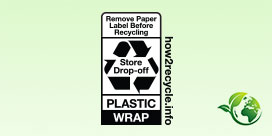
However, I am concerned that not all labels are so easy to peel off. My 10-foot roll of Flex & Seal came to me wrapped in actual Flex & Seal! (How’s that for good advertising? It was very meta.) But both the marketing label (promoting other 3M products) and the UPS label would not peel off cleanly, so I’m not sure if that renders the package un-recycle-able.
HOW TO OPEN FLEX & SEAL PACKAGING
I’ll admit, I was puzzled when my Flex & Seal Shipping Roll (again, wrapped in Flex & Seal) arrived. I saw that I could just cut it open with scissors, but I didn’t want to accidentally cut what was inside. But I also couldn’t just pull on opposite sides of the packaging as if I were opening a bag of potato chips.
In the end, I guessed (correctly), and carefully used the scissors on the corner of the packaging, but I’m betting I wasn’t the only uncertain person, as Scotch™ produced this video to set people straight about three different methods for opening Flex & Seal packaging!
VARIETIES OF FLEX & SEAL SHIPPING ROLL
Scotch™ Flex and Seal Shipping Roll comes in four sizes:
- 10′ long x 15″ wide
- 20′ long x 15″ wide
- 50′ long x 15″ wide
- 200′ long x 15″ wide (suitable for small business shippers or people with LOTS of grandchildren)
As for styling, well, there’s not a lot of variety. The standard is the blue exterior with the grey interior.
Looking for something a bit more festive for the holidays? That regular sky blue is cheery enough (and sorta suitable for Hanukkah) but if you’re looking for something a little more Christmassy, Scotch™ has created a Limited Edition Holiday Color (which you and I may recognize as “red”).
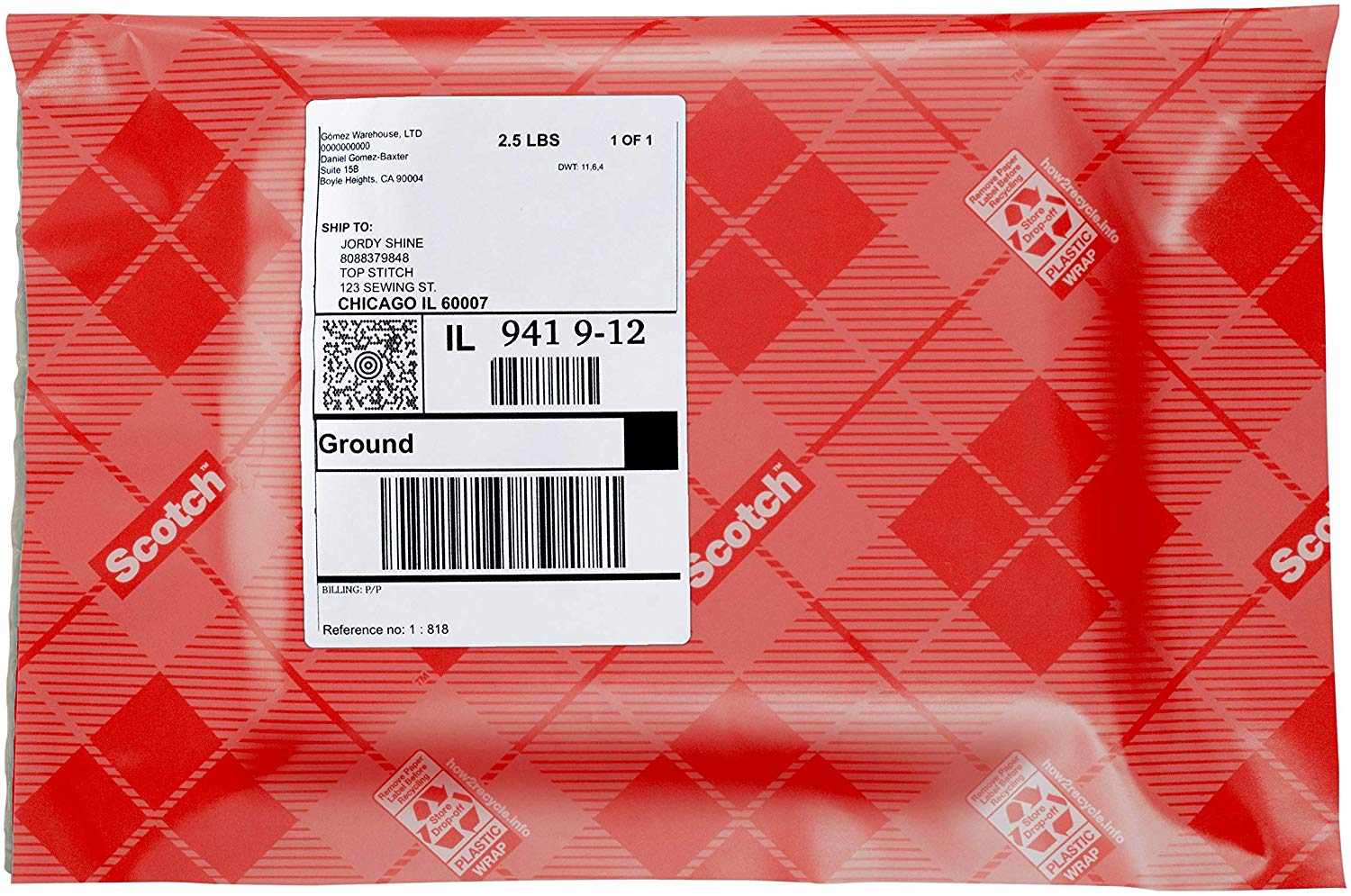
LOCATIONS AND PRICING
Scotch™ Flex & Seal Shipping Roll is available online at Amazon and Shoplet, and at Target, Walmart, Office Depot, and Staples. Prices range from about $8.50 for the 10′ roll to $99 for the 200′ roll.
Disclaimer: As part of a voluntary program, I help 3M evaluate some of their products. 3M sends me free samples and I analyze them, and give my honest opinion on their site. I had just received my 10′ roll when I saw that my colleague Seana Turner had included Flex & Seal in her post, Seana’s Top Gifts for 2019, which gave me the idea to write this post. Be assured that all opinions are my own. (Who else would claim them?)
Avoid the Lost & Found: Keep Track of Your New Goodies with Tile
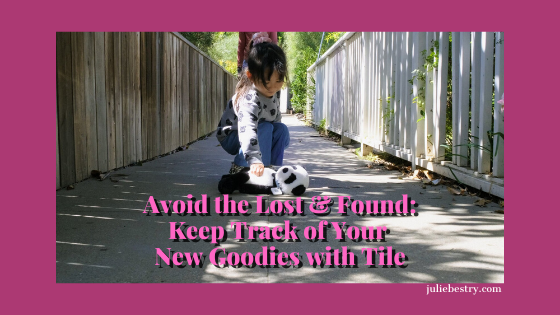
Seek and ye shall find. Or, at least you hope so. But the more stuff you have, the easier it is to lose things.
Earlier this year, Paper Doll shared Bluetooth solutions for keeping track of your gone-missing items in the post Paper Doll Finds Your Lost Keys, Wallets, and Phones: Bluetooth Trackers 2019 and the follow-up, Paper Doll Finds Your Lost Eyeglasses: Technology Beyond Checking the Top of Your Head.
If you are frustrated that your things go missing and you haven’t tried a Bluetooth tracker, this post is for you. With Black Friday, Cyber Monday, and a plethora of holiday gift-shopping situations on the horizon, we are all – ourselves, our families, and all of our recipients – going to have to keep track of stuff and the paraphernalia we need to keep our stuff working. Hence this update post on Tile.
In Paper Doll Finds Your Lost Keys, Wallets, and Phones, we covered Bluetooth basics and the most popular solutions, including Tile. If it’s been a while since you read the post, or you’re new to the world of Bluetooth trackers, I encourage you to revisit that post and see the magic of having tiny doodads keeping track of the things you bury, wander away from, or which wander away from you (in the hands of tiny humans, furry friends, or your last rideshare experience).
Previously, the last line of Tile products offered three main options, the Pro, Mate, and Slim, as it appeared below.

The three designs were different from one another in terms of sizes, Bluetooth ranges, alarm volumes, but all were designed to attach to your possessions (keys, wallets, cameras, umbrellas, fancy water bottles, favorite stuffed animals, backpacks, remote controls, etc.).
The key commonality was that with a quick tap on the app, you could find your lost stuff, and even have it give you a “yoohoo!” (Far from your stuff? As we explained in the original post, Tile’s community of users extends the reach of your search, as if a whole posse of detectives were on the case.)
Recently, Tile introduced a brand-new “hardware” lineup that improves upon the characteristics of the prior projects. Basically, that chart above is “soooo 2019” and the refreshed items include some interesting updates.
TILE SLIM
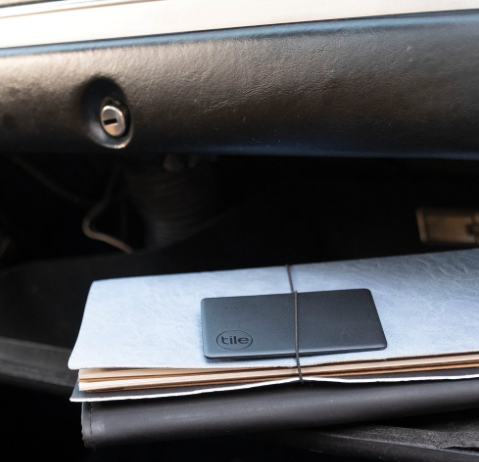
Remember the Tile Slim? (See that old info on the right of the chart?) The NEW Tile Slim has received quite the upgrade! Instead of a flat square, it’s now shaped like a credit card, perfect when you’re looking at a “low-profile” design, like in a wallet or a business card case. (Seriously, have you ever set down your business card case at a conference to shake hands or examine something in an expo or because you’re talking with your hands? No? Just me?)
The Slim is still 2.4mm thick (about the thickness of two credit cards, but wider (86mm instead of 54mm) to fit comfortably in all the places you’d store credit, debit, loyalty, or business cards.
Previously, the Tile Slim had a 1-year built-in (non-replaceable) battery; the battery now lasts three years. The range has been doubled from 100 to 200 feet (from 30 to 61 meters), and has a louder ring to help you find what’s yours more quickly.
The Slim is available in black, only, and costs $29.99.
TILE STICKER

Tile recognized that some stuff is just plain small, and small stuff needs smaller Tiles. Otherwise, your stuff gets lumpy and the “feel” just isn’t right. This led to the new Tile Sticker.
The Sticker is Tile’s smallest tracking solution. These little dots of Bluetooth power are waterproof and adhere to your items with Tile’s time-tested adhesive backing that can stick to anything. (OK, don’t stick it directly on the dog, however often he gets lost! That’s just not cool.)
The Stickers have a 3-year battery life and a range of 150 feet. Like the Slim, the Stickers are only available in Black.
They sell for $39.99 for a 2-pack or $59.99 for a 4-pack.
TILE MATE and PRO (UPDATED)
Tile hasn’t forgotten the rest of their lineup. To round out these improvements, Tile has expanded the Bluetooth range to enable zippier search and more reliable “finding” for both the Tile Mate from 150 to 200 feet (from 45 to 60 meters) and the Tile Pro from 300 to 400 feet (from 90 to 122 meters).
For those who care about styling, the Mate is available in White for $24.99, and the Pro is available in Black or White for $34.99.
HOW TILE WORKS
TILE 2020 LINEUP COMPARED

As you can see, the Tile Pro is the only version that gives you a choice of colors, and it has the loudest ring and double the range of any of the other products. But it’s also the thickest.
The Mate is smaller but thicker than the Slim, and you can replace the battery, but (like the Pro) it’s merely water-resistant, not waterproof like the Slim (and the Stickers). But the Mate does have a replaceable battery.
So, depending on each object you want to track, you’ll want to decide what’s the most important feature(s) for you for that object.
HOW TO CHOOSE
Color – Do you need your Tile to blend in with the surroundings? Do you really need to make a fashion statement? If aesthetics are truly your thing, there are always decorative Tile Skins.
Range – Where do you use your stuff? If you’re affixing it to a remote control or something else that never leaves your house, or if you live in a small apartment rather than a McMansion, a huge range may not be as important as it would be for something you schlep to work, school, and the beach.
Volume – As with range, if you’ve got sharp ears (or a child, teenager, or dog with sharp ears), having the loudest alarm may not be important, but if you’re buying Tiles for the great-grandparents or you work or hang out in a loud environment, the Sticker’s volume may not be loud enough for your needs.
Battery – Ah, the eternal debate: a longer-lasting built-in battery or a shorter, replaceable battery? It’s a personal choice, but I know I’d rather replace a battery than a whole device.
Water-resistance – Is your tiny human carrying her backpack through some raindrops or does she like to dump all the remotes in the (filled) bathtub? It’s worth considering.
Dimensions – How big is the “thing” that you don’t want to lose? How concerned are you about style and fit vs. function?
COMBO and MULTI PACKS
Recognizing that few of us need to track merely one thing, Tile has a variety of combo and multi-packs to fit a range of situations. I encourage you to sit down with your holiday gift list and figure out what gifts you’re giving might be augmented by the insurance policy of a Bluetooth tracker like Tile. Then take a reality check in your household and figure out what everyone is always misplacing, and go from there.
Tile Essentials: 2 Tile Stickers, 1 Tile Slim, 1 Tile Mate available for $69.99
Tile Pro Combo: 2-Pack (one black, one white) at $59.99 and 4-Pack (two black, two white) at $99.99
Tile Mate: 4-Pack for $69.99
Tile Mate/Slim Combo: 2 Mates and 2 Slims, available for $74.99
GOOGLE NEST
In October, Tile partnered with Google to make search even easier via the Google Nest device. So, if you’ve got a Google Nest (formerly Google Home), instead of using your phone and the Tile app, you can ask your Google Assistant to yoohoo your Tile devices for you. So, if you say, “Hey Google, make my wallet ring!” it’ll do that for you. (The 21st century is weird that way.)
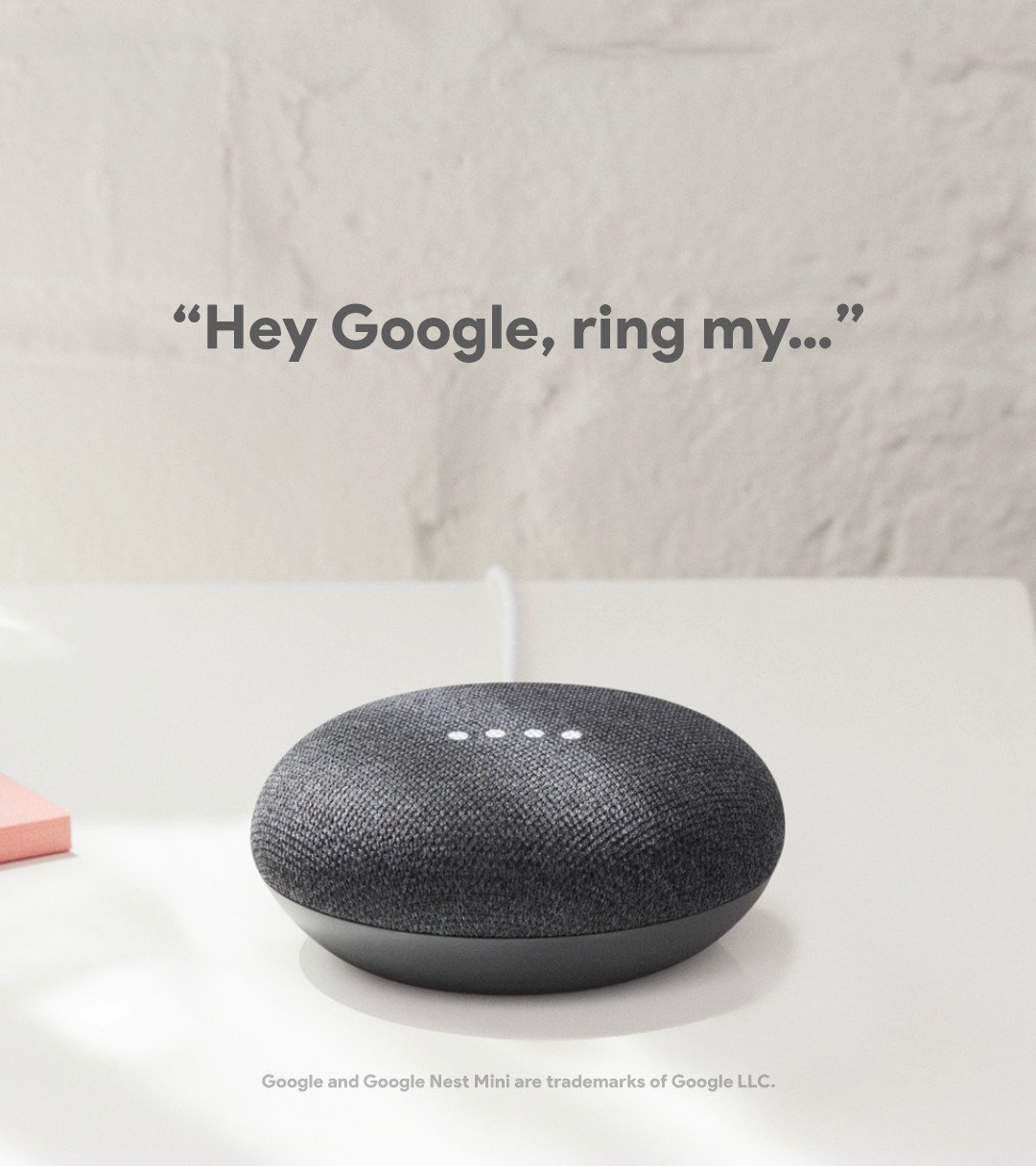
If you don’t have a Nest, you can still tell your Google Assistant what to do. However, although you won’t have to tap your phone, you’ll still need your phone with the Tile app running somewhere nearby so the Tile app can tell your Tile doohickey to ring.
FINAL WORD
No matter what you acquire this holiday season, whether for yourself or for others, Bluetooth trackers are still only part of the story. Whatever you’ve got (or intend to acquire) make sure it serves your needs, and consider letting whatever languishes in drawers and cabinets be a blessing to someone else via donation. Don’t keep what you don’t need. (But if you’re having trouble keeping track of what you do need, Bluetooth trackers are pretty cool.)
You Are Invited to the 2019 Productivity Summit!
What did you accomplish today? Was it everything you’d hoped?
What do you think of when you hear the word “productive” bandied about? There’s a commonly-held but false belief that productivity is just about getting a lot of things done. But productive has two definitions: it can mean both prolific (quantitatively measuring how much gets done) and useful (qualitatively measuring how worthwhile and valuable an endeavor is).
Being productive means not just accomplishing a lot, but accomplishing the right things.
How many times have you gotten to the end of your day and realized that you’d been incredibly busy, completing many tasks (both the ones you planned as well as putting out small fires), but you didn’t feel fulfilled? Perhaps you read lots of blogs (like this one) and books, and have incorporated some of the advice. Maybe you theme your days or time-block your work projects. Hopefully, you eliminate as many interruptions as possible. But you know there’s more you could be doing. You know you could be doing better.
I’m excited to announce that I’m going to be participating in a special project, the brainchild of my colleague Ray Sidney-Smith, whom I met a few years ago when we were getting certified as Evernote consultants. Ray knows how to figure out what someone needs to know and presents that material in a way that’s easy to absorb. So Ray came up with the Productivity Summit!
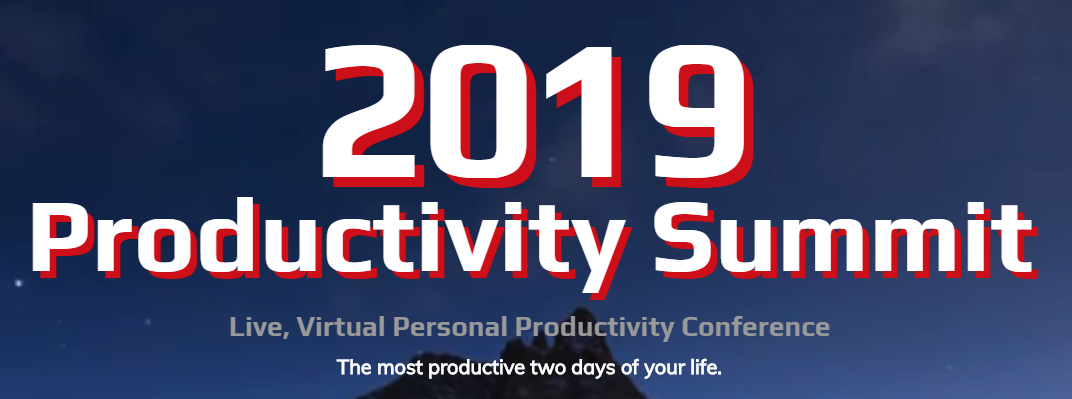
Ray says “The 2019 Productivity Summit is going to be the most productive two days of your life,” and from what I’ve seen, I believe it!
I’ve attended a variety of internet-based conferences and summits on topics ranging from organizing and time management, to ADHD and hoarding, to writing and publishing. The material can be great, but it can often feel a little hokey, as it’s obvious those other virtual summits are just pre-recorded presentations released on a “drip” schedule, with no opportunity for attendees to ask questions or interact with the speakers.
The 2019 Productivity Summit is a LIVE, two-day remote conference with more than 40 expert speakers presenting in real-time about personal productivity, technology, organization, and business development. And your own Paper Doll will be one of them!
PROGRAMMING TRACKS
The 2019 Productivity Summit has four concurrent tracks of programming:
- Productivity – This track focuses very specifically on how to be more personally productive using the speakers’ recommended principles, strategies, and techniques.
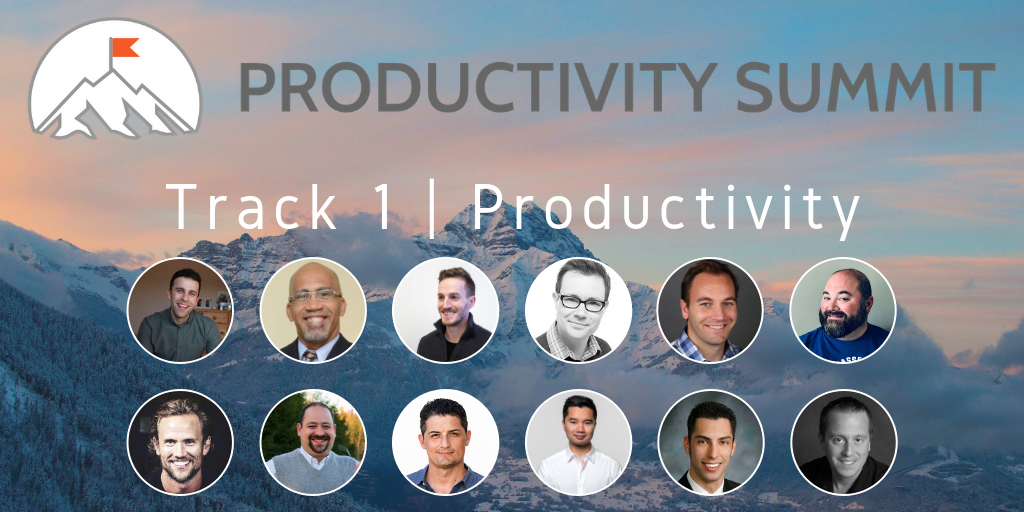
There are some real powerhouse talents in this group, including Canadian rockstar and friend-of-the-blog Mike Vardy, the author/coach/podcaster known as The Productivityist. Where Mike is, the fun follows. I’m also excited to hear what Keep Productive’s Francesco D’Alessio has to say about Notion, a (geeky) up-and-comer that some people thinks give Evernote a run for its money. And Thanh Pham from Asian Efficiency is also on-deck, and his take is always a must-seeand must-listen.
- Technology – This programming track is focused on what and how to use specific technologies to get things done.

As much as I’m truly a Paper Doll, I know how technology is key for making work and life run more efficiently. My colleague Stacey Harmon is my go-to for Evernote coupled with David Allen’s GTD. From the ergonomics of productivity to leveraging systems to specific technologies, this programming track is for those who want to geek out as well as those who just want stuff to work so they can get on with their lives.
- Organization – For this track, it’s about the nitty gritty of getting your home or office more organized – it will cover the physical, intellectual, and psychological skills for dealing with clutter and disorganization.
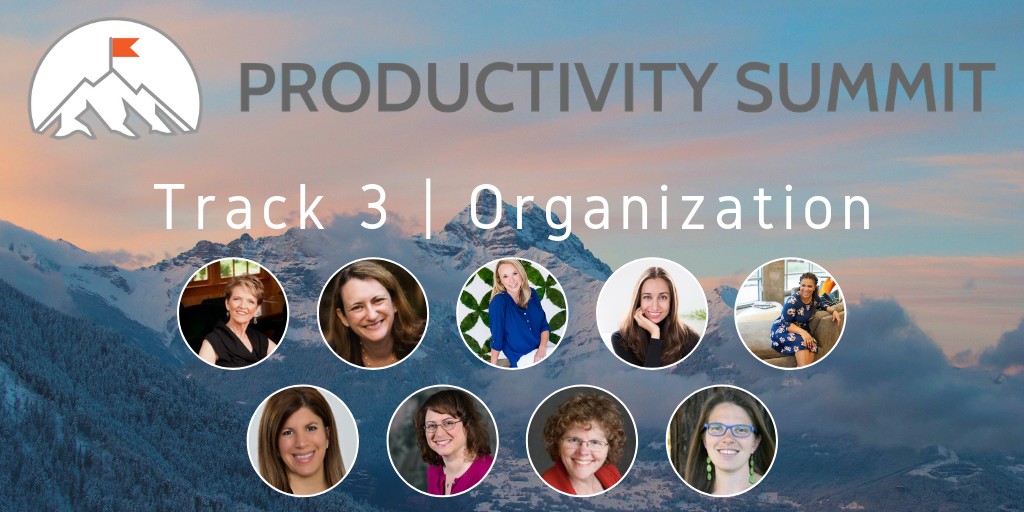
Hey, that’s me up there!
If you follow organizing blogs or the professional organizing industry, you’ll recognize most of the people participating in this programming track. There’s industry standard-bearer Barbara Hemphill, fellow Certified Professional Organizers Kim Oser, Dawn George, and Kacy Paide. We’ll be joined by sharp and savvy NAPO colleagues like Andrea Hancock, Terri Blanchette, Penny Bryant Catterall, and coach Alexis Haselberger. Topics we’re covering range from the economics of clutter to how to organize your digital resources, from conquering fear of letting go of what’s on your desk to trying to go paperless when you can’t let go of the paper. Me? My presentation is called Organize for Maximum Productivity When You Work From Home.
- Business Development – This track is for those looking to build or grow their businesses more effectively and efficiently.
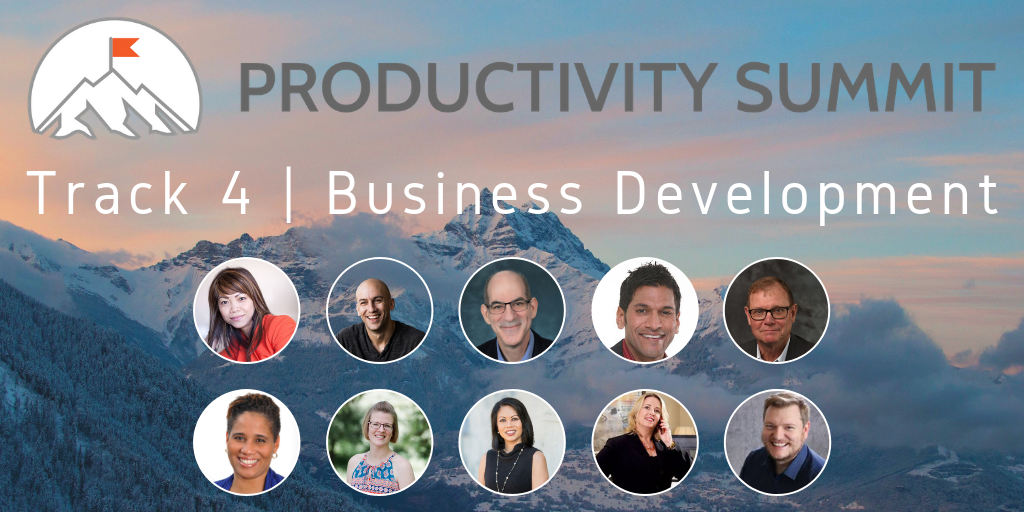
This is another power-packed lineup. These speakers will cover general business leadership topics like improving focus, growing sales, and developing entrepreneurial mindsets, but also delve into niche issues like video marketing, podcasting, and publishing. My longtime colleague, Nicole Chamblin is first up on Saturday morning, so I’ll be checking her out while I wait in the wings.
PRODUCTIVITY PANELS AND KEYNOTE AND DIGITAL INTERACTIVES, OH MY!
In addition to these concurrent programming tracks, there will be panel discussions across specific time slots. On Friday, October 4, 2019, summit host, Ray Sidney-Smith, Google Small Business Advisor for Productivity, will lead a panel of productivity technology experts entitled, “The Future of Productivity Technology.”
Then, on Saturday, October 5, 2019, Demir Bentley of Lifehack Bootcamp and Lifehack Tribe, will be keynoting the Summit with his presentation, “The Biggest Cover Up In Productivity History.”
There will also be a Digital Interactives area where speakers will be placing education-oriented quizzes (not the Facebook-style kind), polls, and more so you can engage with what you learn at the Summit. Finally, each day will end with with live, virtual networking events for summit attendees.
THE DETAILS
The 2019 Productivity Summit is free to attend live, and it’s all accessible through your Web browser. Visit the 2019 Productivity Summit page to see all the participants and topics, and I bet you’ll be as impressed as I am.
Register and get complimentary replays of the sessions through Sunday evening (Eastern time), October 6, 2019 , so you can watch missed sessions or rewatch sessions you found especially helpful.
Want more time to watch? You can buy access to the 2019 Summit video replay library. As I write this, early bird pricing is still available (until 9/13/19 4:59 PM US EDT); it goes up as the summit nears, and will rise again after the complimentary replays end.
Reach the summit – the 2019 Productivity Summit – and learn how to get more of the right things done.
Paper Doll on the Smead Podcast: Essential Lists For Organized Travel
“Twenty years from now you will be more disappointed by the things that you didn’t do than by the ones you did do. So throw off the bowlines. Sail away from the safe harbor. Catch the trade winds in your sails. Explore. Dream. Discover.”
~ Mark Twain
Whether you’re going over the river and through the woods for a holiday with Grandma or jet-setting off to some foreign rendezvous, travel can be both exciting and nervewracking. There are so many issues, from worrying that you’ll forget your medication to figuring out how to pack properly for the weather, that it’s easy to become anxious or overwhelmed.
Taking Twain’s message to heart, I would rather spend my twilight years remembering the joys of my madcap adventures (even if they involved some momentary anxiety) than basking in the coziness of never making a misstep due to never having taken a step at all.
Readers, you’ve heard me say this before: organizing cannot prevent all catastrophes, but it can prevent them from being so catastrophic.
Organizing cannot prevent all catastrophes, but it can prevent them from being so catastrophic. Share on XI’m a big believer that lists help keep our space and time organized, and work particularly well for banishing – or at least keeping at bay – some of that pre-travel anxiety.
You may recall my post from last fall, Paper Doll’s 5 Essential Lists For Planning an International Vacation, which I wrote after returning from my grand tour of Italy. Recently, that post prompted a great two-part conversation with John Hunt on the excellent Smead video podcast, Keeping You Organized.
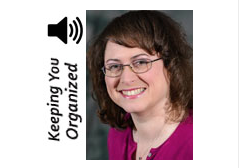
We discussed exactly how you can use lists to conquer your trip-preparation fears and travel more confidently. For convenience, both parts of our conversation appear below.
Essential List for Organized Travel – Part 1 (Keeping You Organized, episode #263)
Essential List for Organized Travel – Part 2 (Keeping You Organized, episode #264)
If you’d rather listen to the podcasts (perhaps while packing or roaming through romantic, far-flung airports than be distracted by my hair (which I swear always looks better ten minutes before the podcast starts), you can visit the podcast pages directly at Smead and download the mp3s:
Essential List for Organized Travel – Part 1 (Keeping You Organized, episode #263) Audio Only
Essential List for Organized Travel – Part 2 (Keeping You Organized, episode #264) Audio Only
On the podcasts, I talked about the kinds of lists I use, as well as the apps, products, and services that I think help create a more organized travel experience. One of those items wasn’t widely available yet when I went to Italy, nor when I wrote my recap.
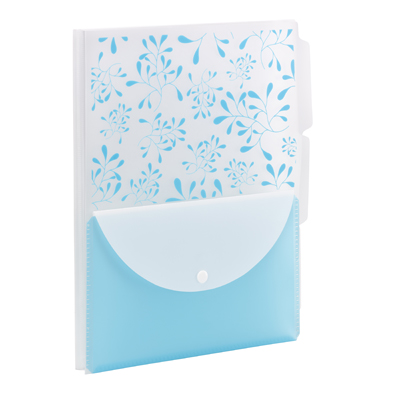
Last February, I was watching Smead’s myOrganized.life daily Facebook show. When I tuned in, I learned that friend-of-the-blog and Smead personality Leiann Thompson (John Hunt’s partner in crime) was stuck in a snowstorm and John was on his own, touting a new product: the Smead Poly Three-Divider Travel Organizer File.
Once John showed off the Travel Organizer File, I knew I had to get a closer look at this hybrid tool for organizing travel documents and necessities. It’s made of durable poly material, so it’s tear- and water-resistant. The back portion of the letter-sized organizer has three 1/3-cut tabbed divider sections, each of which has a 25-sheet storage capacity. The sections are useful for sorting documents by:
- different days of your itinerary
- different aspects of your trip (family reunion notes, conference documents, sightseeing itineraries), or
- different travel elements (airline reservations, hotel bookings, ground transportation info, etc.)
The Smead Poly Three-Divider Travel Organizer File also has a snap-closure pocket (also made of poly material) for collating travel expense receipts, baggage claim or valet tickets, restaurant/business cards, walking tour maps, and anything you collect along the way.
Smead has three colorful, fun designs, all of which give your enclosed documents some privacy from prying eyes. (You know, there’s always that one seatmate looking over your shoulder!) The teal-white flowered is shown above; Smead also makes purple and teal versions with a charcoal privacy design (below):
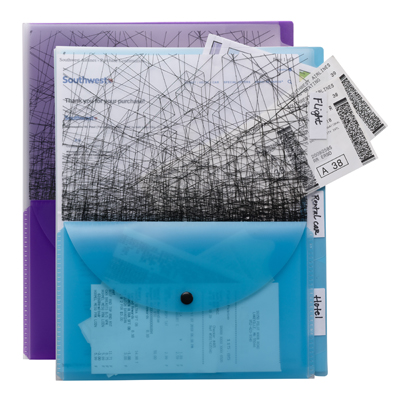 You can find a two-pack of the Smead Poly Three-Divider Travel Organizers at Amazon for around $9, as well as at Smead, and most office supply stores and stationers.
You can find a two-pack of the Smead Poly Three-Divider Travel Organizers at Amazon for around $9, as well as at Smead, and most office supply stores and stationers.
Happy (organized) traveling!




Follow Me